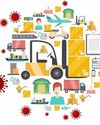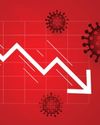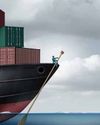Container traffic in South Asia has increased fourfold since the past decade, but logistics infrastructure has not geared up to support the rise in flow of cargo. South Asian economies need to put a concerted effort to resolve logistics issues that could have interrelated angles rather than implementing isolated measures.

South Asia’s trade almost doubled in the past decade, with trade as a percentage of GDP increasing by 18 percentage points between 2000 and 2014.Trade accounted for a smaller share of GDP in South Asia (47 per cent) than in East Asia (55 per cent) in 2014. Since 2000 the region has also enjoyed the second-highest economic growth in the world (after East Asia), growing at an average annual rate of 6.8 per cent.
Since 2000, container traffic in the region increased by a factor of more than four. Capacity also increased, but it grew much more slowly than cargo growth. As a consequence of the growth in trade traffic, congestion at container ports across South Asia increased between 2000 and 2012. Ports have offset longer waiting times by improving the efficiency of their operations at the berthing stage. More efficient use of port facilities, together with improvements in the scale of operations,were the main drivers of increase in total factor productivity (TFP) in South Asia. On average, South Asian container ports experienced the largest improvement in TFP among ports in the Indian and Western Pacific Oceans (80 per cent versus 55 per cent for East Asia) between 2000 and 2010.
Drivers for container throughput
この記事は Maritime Gateway の September 2017 版に掲載されています。
7 日間の Magzter GOLD 無料トライアルを開始して、何千もの厳選されたプレミアム ストーリー、9,000 以上の雑誌や新聞にアクセスしてください。
すでに購読者です ? サインイン
この記事は Maritime Gateway の September 2017 版に掲載されています。
7 日間の Magzter GOLD 無料トライアルを開始して、何千もの厳選されたプレミアム ストーリー、9,000 以上の雑誌や新聞にアクセスしてください。
すでに購読者です? サインイン

Impact Of Covid-19 On Shipping And Logistics
Industry stalwarts discuss threadbare the prevailing logistics and supply chain scenario and issues in clearing cargo during the COVID-19 lockdown

Digital Platforms Defy Lockdown
Digital trading modules such as eNAM are enabling farmers to move their produce from farm to market even during the lockdown

GARMENT TRADE TRAMPLED
As retailers face a shutdown in US and Europe, the cascading affect has caused mass cancellation of orders in Bangladesh

TRADE RESUMES WITH CHINA
While India has allowed uninterrupted movement of imports into Nepal even during lockdown, China is reopening its borders as it emerges from the pandemic
LESS HUMAN INTENSIVE, MORE DATA DRIVEN
AI provides transformational opportunity for logistics industry by improving customer experience, operational efficiency, faster turnaround time and lower cost while ensuring security and transparency. Macro environment requires industry to transform to be less human intensive, agile and data driven, all of which can be accelerated by AI adoption, shares Gangadhar Gude, Founder & CEO, atai.ai

SHAKEN AND STIRRED
The COVID-19 pandemic has partially paralysed the logistics and supply chain, but the industry is still deterred to ensure supply of essentials continues

TRADE STUCK, ECONOMY SLOWS DOWN
Sri Lankan economy slows down as trade deficit widens and supply chain disrupts amidst lockdown

LENDING INTELLIGENCE TO SUPPLY CHAIN
If you’re shipping millions of dollars’ worth of pharmaceuticals, high-end electronics, expensive seafood, or precious metals, what would you be willing to pay for the ability to ‘ask’ your shipment where it is right now and whether it’s ok? What would you pay for a freight smart enough to raise an alarm before it spoils? Artificial Intelligence enables that and much more…

CONTAINER LINES SIGNAL ‘SOS'
As the per-unit cost of operations increases many lines are forced to blank sailings which has hit their bottom line real hard. The Government and Terminal Operators therefore need to actively consider reduction in Vessel Related Costs

IMO 2020 And The Covid-19 Curse
The COVID-19 outbreak has shaken and stirred the already volatile bunker market. While the refiners adjust their capacities and shipping lines choose their path to compliance, the market dynamics are yet to reach an equilibrium